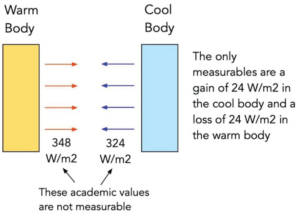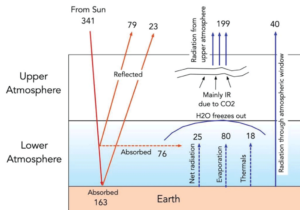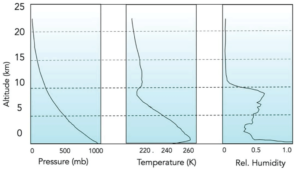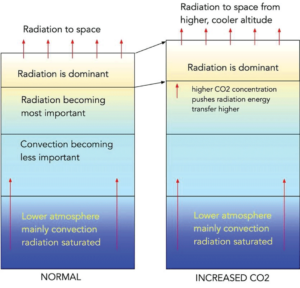How Increased CO2 Warms the Earth-Two Contexts for the Greenhouse Gas Effect
Introduction
The rising concentration of carbon dioxide (CO₂) in the Earth’s atmosphere has profound implications for the planet’s climate system. Understanding how CO₂ contributes to global warming is a critical aspect of Atmospheric Science, Ecosystem Resilience, and Earth Science. A recent publication titled “How Increased CO₂ Warms the Earth: Two Contexts for the Greenhouse Gas Effect”, available through IgMin Research, sheds light on the mechanisms behind CO₂-induced warming and addresses common misconceptions about the greenhouse effect.
In this blog post, we will explore the key findings from the study and discuss the broader implications for Atmospheric Science, Ecosystem Resilience, and Earth Science.
For more insights, explore the full study: Full Text | PDF
The Greenhouse Effect: Two Contexts for Understanding CO₂-Induced Warming
The study distinguishes between two different contexts for understanding the greenhouse effect:
- The Fundamental Greenhouse Gas Effect: This hypothetical context imagines a dry Earth with no water vapor or CO₂. As greenhouse gases are added to the atmosphere, they act as a “thermal blanket,” reducing infrared (IR) radiation from the Earth’s surface to space and warming the planet.
- The Current Greenhouse Gas Effect: This context examines how adding more CO₂ to the current atmosphere impacts global temperatures. Unlike the fundamental greenhouse gas effect, the current effect shows that adding CO₂ primarily increases the altitude at which the Earth radiates energy to space, thereby reducing the planet’s ability to shed energy.
Understanding these two contexts is crucial for appreciating the nuances of how increased CO₂ levels contribute to global warming.
 Figure 1: Radiant heat transfer between warm and cool bodies.
Figure 1: Radiant heat transfer between warm and cool bodies.
The Earth’s Energy Budget: Key Concepts in Atmospheric Science
The study emphasizes the importance of understanding the Earth’s energy budget to grasp the impact of rising CO₂ levels. The Earth’s energy system operates in a balance between incoming solar radiation and outgoing infrared radiation. Any disruption to this balance results in warming or cooling.
Key components of the Earth’s energy budget include:
- Incoming Solar Irradiance: The Sun provides energy to the Earth in the form of solar radiation, which is absorbed by the atmosphere, surface, and oceans.
- Reflected Energy: Some solar energy is reflected back into space by the Earth’s surface and atmosphere.
- Radiated Energy: The Earth radiates energy back into space as infrared radiation.
When CO₂ concentrations increase, they reduce the Earth’s ability to radiate energy to space, causing a warming effect.
 Figure 2: Radiant heat transfer from warm plate to cold plate separated by vacuum or separated by IR absorbing gas.
Figure 2: Radiant heat transfer from warm plate to cold plate separated by vacuum or separated by IR absorbing gas.
How Increased CO₂ Affects Ecosystem Resilience
The impact of rising CO₂ levels extends beyond atmospheric changes to affect ecosystems worldwide. Ecosystem Resilience refers to the ability of ecosystems to absorb disturbances and maintain their functionality.
Rising global temperatures due to increased CO₂ can disrupt ecosystems in several ways:
- Shifts in Species Distribution: Many species may migrate to cooler regions to escape rising temperatures.
- Loss of Biodiversity: Ecosystems with low resilience are more vulnerable to species loss.
- Changes in Phenology: The timing of biological events, such as blooming or migration, may change, affecting ecosystem interactions.
Understanding the link between atmospheric science and ecosystem resilience is crucial for developing strategies to mitigate the impact of climate change.
Earth Science Perspectives on Global Warming
Earth Science provides a broader perspective on how geological and physical processes interact with atmospheric changes. The study highlights several Earth science concepts relevant to understanding global warming:
- Carbon Cycle: The movement of carbon through the Earth’s systems (atmosphere, oceans, soil, and living organisms) plays a key role in regulating global temperatures.
- Albedo Effect: The reflectivity of the Earth’s surface affects how much solar energy is absorbed. Melting ice reduces the Earth’s albedo, leading to more heat absorption.
- Ocean Circulation: Changes in ocean currents can influence global climate patterns and impact weather systems.
The integration of Earth science with atmospheric science is essential for a holistic understanding of climate dynamics.
 Figure 3: Energy flows in the Earth’s system. (Based on LTWS references).
Figure 3: Energy flows in the Earth’s system. (Based on LTWS references).
Addressing Misconceptions About the Greenhouse Effect
The study addresses several common misconceptions about the greenhouse effect:
- Misconception: The Greenhouse Effect Works Like a Thermal Blanket
- The traditional analogy of a “thermal blanket” is only partially accurate. The current greenhouse gas effect primarily works by raising the altitude at which the Earth radiates energy to space.
- Misconception: CO₂ Directly Traps Heat
- CO₂ doesn’t trap heat like a blanket. Instead, it affects the radiative balance by altering the altitude of energy emissions.
- Misconception: All Greenhouse Gases Have the Same Impact
- Different greenhouse gases have varying impacts on global warming. For example, water vapor has a more significant effect on the lower atmosphere, while CO₂ affects higher altitudes.
Addressing these misconceptions is important for improving public understanding of climate science.
 Figure 4: Pressure, temperature, and relative humidity vs. altitude [8].
Figure 4: Pressure, temperature, and relative humidity vs. altitude [8].
The Role of Atmospheric Science in Mitigating Climate Change
Atmospheric Science plays a critical role in developing strategies to mitigate climate change. By understanding the mechanisms of global warming, scientists can develop effective policies to reduce CO₂ emissions and adapt to changing climate conditions.
Key strategies for mitigating climate change include:
- Reducing Fossil Fuel Consumption: Transitioning to renewable energy sources can significantly reduce CO₂ emissions.
- Carbon Capture and Storage (CCS): Capturing CO₂ emissions from industrial processes and storing them underground can help reduce atmospheric CO₂ levels.
- Reforestation: Planting trees can increase carbon sequestration and reduce CO₂ levels.
The study emphasizes that a comprehensive understanding of atmospheric science is essential for implementing these strategies effectively.
 Figure 5: Qualitative sketch to show radiation is dominant at the highest altitude. By adding CO2 to the atmosphere, radiative energy transport is carried to a higher altitude where it is colder, reducing the radiant power emitted by the upper atmosphere.
Figure 5: Qualitative sketch to show radiation is dominant at the highest altitude. By adding CO2 to the atmosphere, radiative energy transport is carried to a higher altitude where it is colder, reducing the radiant power emitted by the upper atmosphere.
Conclusion
The study “How Increased CO₂ Warms the Earth: Two Contexts for the Greenhouse Gas Effect” provides valuable insights into the mechanisms of global warming and addresses common misconceptions about the greenhouse effect. By integrating concepts from Atmospheric Science, Ecosystem Resilience, and Earth Science, researchers can develop a more nuanced understanding of climate dynamics and implement effective strategies to mitigate the impact of rising CO₂ levels.
